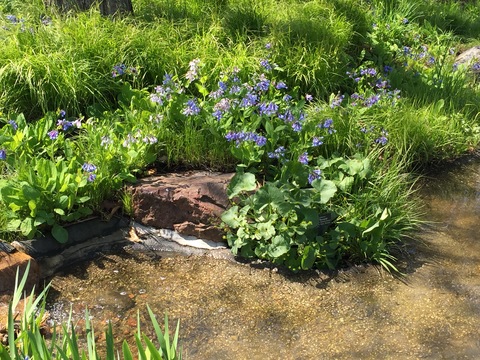Virginia Bluebells (Mertensia virginica) [mer-TEN-see-ah ver-JIN-ih-kah] |
|
| Other Names | Mertensia verginica, Mertensia virginica (unmarked), Mertensia virginica 1 Gal., Mertensia virginica (NGN), Mertensia virginica NGN, Mertensia virginica NGN #1, Mertensia virginica Pint, Mertensia virginica NGN Pint, Mertensia virginica #1 |
| Family | Boraginaceae |
| Teaser | Virginia Bluebells enchant with their delicate, bell-shaped flowers that bloom in vibrant shades of blue, creating a stunning carpet of color in spring. These perennial wildflowers thrive in woodland areas adding charm to natural landscapes. |
| Description |
Mertensia virginica, commonly called Virginia bluebells, is a charming, native woodland perennial that can bring a stunning burst of spring color to shaded garden areas. In early spring, the plant produces clusters of nodding, bell-shaped flowers in shades of blue, lavender, and pink that rise above the large, soft green leaves. As the flowers fade, the foliage goes dormant by midsummer, making Virginia bluebells an excellent companion plant for summer-flowering perennials and annuals. This wildflower prefers moist, well-drained, humus-rich soil and partial to full shade, thriving under the dappled light of deciduous trees. Virginia bluebells spread slowly by rhizomes, forming gentle colonies that can be divided and transplanted. Their delicate, yet bold blooms make them a beloved addition to woodland gardens, naturalized areas, and partially shaded perennial beds and borders. |
| Plant Data | |
| I am a... | Deciduous Perennial Clumping |
| Where to Find It | Virginia Bluebells are native wildflowers which have become garden favorites. The largest amount are found at the north end of the woods along the combined western/central paths, mixed among the Ostrich Fern. There are also a large number to the south of the south path. |
| How to Recognize It | Virginia Bluebells are familiar because they appear in garden settings in Chicagoland. In early spring, pink/purple buds open into trumpet-like blue flowers on short slender stalks at the end of branching stems. |
| Why to Like | This native spring ephemeral has gorgeous blue & purple flowers in spring. Both flowers and leaves are edible and can be added to salads or a stir-fry. |
| Mature Size | 18 - 24 inches tall. 18 - 24 inches wide. |
| Sun Exposure | Full Shade - Full Shade |
| Moisture Tolerance | Medium - : |
| Zones | 3a - 9b |
| Tags | Illinois Native, Wet Site Tolerant, Spring Ephemeral |
| Bloom Period | April - May |
| Flower Color | Blues & pink
|
| Animals That Use It | |
| Data Sheets | |
|
More Photos: Google Image Search & Flickr |
|


















































|
|
